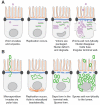Caenorhabditis elegans as a model for intracellular pathogen infection
- PMID: 23617769
- PMCID: PMC3894601
- DOI: 10.1111/cmi.12152
Caenorhabditis elegans as a model for intracellular pathogen infection
Abstract
The genetically tractable nematode Caenorhabditis elegans is a convenient host for studies of pathogen infection. With the recent identification of two types of natural intracellular pathogens of C. elegans, this host now provides the opportunity to examine interactions and defence against intracellular pathogens in a whole-animal model for infection. C. elegans is the natural host for a genus of microsporidia, which comprise a phylum of fungal-related pathogens of widespread importance for agriculture and medicine. More recently, C. elegans has been shown to be a natural host for viruses related to the Nodaviridae family. Both microsporidian and viral pathogens infect the C. elegans intestine, which is composed of cells that share striking similarities to human intestinal epithelial cells. Because C. elegans nematodes are transparent, these infections provide a unique opportunity to visualize differentiated intestinal cells in vivo during the course of intracellular infection. Together, these two natural pathogens of C. elegans provide powerful systems in which to study microbial pathogenesis and host responses to intracellular infection.
© 2013 John Wiley & Sons Ltd.
Figures


References
Publication types
MeSH terms
Grants and funding
LinkOut - more resources
Full Text Sources
Other Literature Sources

